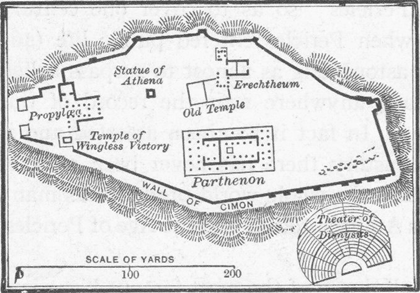| Acropolis of Athens Map |
|---|
| www.studenthandouts.com > World History > Ancient Greece > Images of Ancient Greece |
|
Map of the Plan of the Acropolis in Athens, Greece Many important structures, particularly the Parthenon, are currently being restored. The city of Athens was named in honor of the Greek goddess Athena. Athena was the goddess of war and wisdom. A large statue of Athena was originally placed in the Parthenon. According to Greek mythology, Athena was born from the head of Zeus. The Acropolis, located in the heart of Athens, played a significant role in ancient Greece on multiple levels. Click here to enlarge.  Religious and Cultural Center: The Acropolis was the religious and cultural center of ancient Athens. It was home to several important temples and monuments, the most famous of which is the Parthenon, dedicated to the goddess Athena, the city's patron deity. The Acropolis also housed the Erechtheion, dedicated to both Athena and Poseidon.
Religious and Cultural Center: The Acropolis was the religious and cultural center of ancient Athens. It was home to several important temples and monuments, the most famous of which is the Parthenon, dedicated to the goddess Athena, the city's patron deity. The Acropolis also housed the Erechtheion, dedicated to both Athena and Poseidon. Symbol of Athenian Power: The Acropolis was not only a religious site but also a symbol of Athens' power and cultural achievements. The construction of the Parthenon and other structures showcased the city's wealth and cultural prowess. Political and Civic Functions: The Acropolis was a place for political and civic functions. The citizens of Athens would gather on the Acropolis for various events, including assemblies and festivals. It was a focal point of democratic governance. Celebration of Arts and Learning: The Acropolis was a hub of artistic and intellectual activity. It hosted various cultural and intellectual gatherings, making it a center of learning and the arts. Athenians celebrated literature, philosophy, and the arts in this historic setting. Military Significance: In times of conflict, the Acropolis had military importance. It provided a strong defensive position and often served as a refuge for Athenians during invasions. Architectural Achievement: The construction and design of the buildings on the Acropolis were architectural marvels of their time. The use of the Doric and Ionic architectural styles in the Parthenon and Erechtheion reflected the cultural and artistic achievements of the period. Cultural Identity: The Acropolis was a physical manifestation of Athens' cultural identity and civic pride. The structures on the Acropolis embodied the ideals of democracy, intellectual pursuit, and artistic expression, reinforcing the sense of Athenian exceptionalism. Tourism and Scholarship: Even in ancient times, the Acropolis attracted visitors and scholars who marveled at its grandeur and studied its architectural and cultural significance. Today, the Acropolis remains an iconic symbol of ancient Greece and Western civilization. Its ruins and historical significance make it one of the most famous and visited archaeological sites in the world. The enduring legacy of the Acropolis underscores its profound role in the history of ancient Greece and its continued cultural and historical importance. |
 |
 |
 |
 |
 |
 |
|---|
| Ancient Greece Books and Films | Ancient Greece Outlines and PowerPoints |
| Ancient Greece Maps and Pictures | Ancient Greece Study Games |
| Ancient Greece Miscellany | Ancient Greece Worksheets |
| www.studenthandouts.com > World History > Ancient Greece > Images of Ancient Greece |








